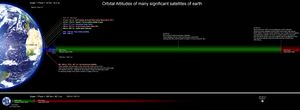مدار أرضي مرتفع

المدار الأرضي المرتفع high Earth orbit، هو مدار أرضي يعلو المدار الأرضي الجغرافي المتزامن (35.786 كم) away from Earth.[1] In this article, the non-standard abbreviation of HEO is used for high Earth orbit.[2]
The development of HEO technology has had a significant impact on space exploration and has paved the way for future missions to deep space. The ability to place satellites in HEO has allowed scientists to make groundbreaking discoveries in astronomy and Earth science, while also enabling global communication and navigation systems.[3]
. . . . . . . . . . . . . . . . . . . . . . . . . . . . . . . . . . . . . . . . . . . . . . . . . . . . . . . . . . . . . . . . . . . . . . . . . . . . . . . . . . . . . . . . . . . . . . . . . . . . . . . . . . . . . . . . . . . . . . . . . . . . . . . . . . . . . . . . . . . . . . . . . . . . . . . . . . . . . . . . . . . . . . . .
Common types of high Earth orbits
| Orbit | Name |
|---|---|
| GEO | Geostationary orbit |
| GSO | Geosynchronous orbit |
| GTO | Geostationary transfer orbit |
| HEO | Highly elliptical orbit |
| NRHO | Near-rectilinear halo orbit |
Satellites in High Earth orbits are primarily used for communication, navigation, scientific research, and military applications.[4] One of the main benefits of HEO is that it provides a nearly unobstructed view of the Earth and deep space. This makes it an ideal location for astronomical observations and Earth monitoring. In addition, satellites in HEO can provide a continuous coverage of the Earth's surface, making it very useful for communication and navigation purposes.[5] A variety of satellites, such as TESS,[6] have been placed in HEO.
There are four main reasons that most satellite are placed in lower orbits. First, a HEO can take a month or more per orbit. This is because HEOs are very large orbits and move at only 7000 mph. Meanwhile, a LEO (low Earth orbit) can take less than 90 minutes.[7] So, for satellites that need to orbit quickly, HEO is not a good fit. Second, HEOs take far more energy to place a satellite into than LEOs. To place a satellite into HEO takes nearly as much energy as to place it into a heliocentric orbit. For example, an expended Falcon 9 can carry 50,000 pounds to LEO. However, it can only carry around 10,000 pounds to HEO. [8] This means that it costs 5 times more to place a payload in HEO versus placing it in LEO. Third, HEOs are extremely far from Earth. This means that there is a constant communication delay when sending signals to and from the satellite. This is actually because the signals can only travel at the speed of light. This means that it can take around 0.1 to 4.5 seconds in delay time each way. This makes it useless for internet, and hard to use for other things as well. The fourth reason is radiation. HEO is outside of the magnetic field of Earth. This means that there is far more radiation in HEO. As a result, spacecraft in HEO require specialized equipment and shielding to protect them from radiation. As a result, only satellites that require the unique characteristics of HEO use this orbit.
A special case of a high Earth orbit is the highly elliptical orbit where altitude at perigee may reach as low as 2,000 km (1,200 mi).
أمثلة على سواتل في المدار الأرضي المرتفع
| الاسم | رقم التعريف العالمي للأجسام الفضائية |
تاريخ الإطلاق | الحضيض القمري | الأوج | الدور المداري | الميل |
|---|---|---|---|---|---|---|
| ڤـِلا 1أ[9][10] | 1963-039A | 1963-10-17 | 101,925 كم | 116.528 كم | 6.519.6 متوسط | 37.8 درجة |
| مولنيا 1-01[11] | 1965-030A | 1965-04-23 | 538 كم | 39.000 كم | 708 دقيقة | 65 درجة |
الهوامش
- ^ الدورات والسرعات المدارية تـُحسب باستخدام العلاقات 4π2R3 = T²GM و V2R = GM، حيث R هو نصف قطر المدار بالمتر؛ T هي orbital period بالثانية؛ V هي السرعة المدارية بالـ m/s؛ G هي ثابت الجاذبية، تقريباً 6.673×10−11 مب²/كج²؛ M هي كتلة الأرض، تقريباً 5.98×1024 kg (1.318×1025 lb).
- ^ تقريباً 8.6 ضعف (في نصف القطر والطول) حين يكون القمر أقرب ما يكون (أي: 363,104 km/42,164 km)، إلى 9.6 أضعاف حين يكون القمر أبعد ما يكون حين يكون القمر أبعد ما يكون (أي: 405,696 km/42,164 km).
المصادر
- ^ "Catalog of Earth Satellite Orbits". earthobservatory.nasa.gov (in الإنجليزية). NASA Earth Observatory. 2009-09-04. p. 1. Retrieved 2023-04-05.
- ^ "Types of Orbits". spacefoundation.org. Space Foundation. Retrieved 2023-04-22.
- ^ "Catalog of Earth Satellite Orbits: Three Classes of Orbit". earthobservatory.nasa.gov (in الإنجليزية). NASA Earth Observatory. 2009-09-04. p. 2. Retrieved 2023-04-05.
- ^ "Types of Orbits". spacefoundation.org. Retrieved April 22, 2023.
- ^ "Advantages of HEO Highly Elliptical Orbit | Disadvantages of HEO orbit".
- ^ خطأ استشهاد: وسم
<ref>غير صحيح؛ لا نص تم توفيره للمراجع المسماة:0 - ^ "Popular Orbits 101". Aerospace Security (in الإنجليزية الأمريكية). 30 November 2017. Retrieved 2023-04-05.
- ^ "Capabilities & Services" (PDF). spacex.com. Retrieved April 22, 2023.
- ^ Vela at Encyclopedia Astronautica
- ^ تفاصيل المسار للساتل Vela 1A من المركز الوطني بيانات علوم الفضاء
- ^ nssdc.gsfc.nasa.gov/nmc/spacecraftOrbit.do?id=1965-030A

